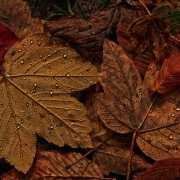Stephanosporium
Stephanosporium is a genus that lacks a known sexual state and thus belongs to the Fungi Imperfecti. It is a species of Oidiodendron cerealis, which is quite distinct from other Oidiodendron species, and is often placed in a separate genus Stephanosporium by some taxonomists. It has distincitve spores and can be recognized on spore trap samples. It is generally classified as a dematiaceous (dark-walled) fungus. This genus is most closely related to Dactylaria and Scolecobasidium. Opinions differ regarding the taxonomy of these three genera and are considered by many to be synonyms. All three genera are listed in Ainsworth & Bisby’s Dictionary of the Fungi as legitimate genera.
There have been several reports of opportunistic infections caused by these genera but a true pathogenic role had not been firmly establishes. No information is available regarding upper respiratory health effects, or toxicity. Allergenicity has not been studied. As to health effects, one isolation from a case of neurodermitis nuchae in 1969 exists for Odiodendron cerealis/Stephanosporium cereale, with no reports for other Odiodendron species. No information is available regarding toxicity. Allergenicity has not been studied. May be identified on surfaces by tape lifts, tease mounts from bulk samples, and in air by culturable (Andersen) sampling. Stephanosporium has distinctive spores and can also be recognized on spore trap samples. Spores of other Odiodendron species are arthrospores without distinctive morphology and would be recognized as such on spore trap samples. Natural habitat includes soil, litter, wood, and bark. Stephanosporium cereale has been isolated from air, paper, soil, and textiles.
Opportunistic Pathogen – Causes infection only when the weak or injured condition of the person gives the agent opportunity to infect. Rarely infect patients who are otherwise healthy.
Further Reading
- Abdel-Gawad, K.M., & Zohri, A.A., Fungal flora and mycotoxins of six kinds of nut seeds for human consumption in Saudi Arabia, Mycopathologia 124 (1993) 55-64.
- Aisner, J., Schimpff, S.C., Bennett, J.E., Young, V.M., Wiernik, P.H., Aspergillus infections in cancer patiens. Association with fireproofing materials in a new hospital. J.Am. Med. Assoc. 235 (1976) 411-412.
- Ajello, L., Hyalohyphomycosis and phaeohyphomycosis: two global disease entities of public health importance. Eur. J. Epidemiol. 1(1986) 243-251.
- Al-Suwaine, A.S., Bahkali, A.H., Hasnain, S.M., Seasonal incidence of airborne fungal allergens in Riyadh, Saudi Arabia. Mycopathologia 145(1999)15-22.
- Alberts, B., Bray, D., Lewis, J., Raff, M., Roberts, K.,Watson, J.D., in “Molecular Biology of the Cell”, published by Garland Publishing, Inc, 1983.
- Ali, M.I., Salama, A.M., Ali, M.T., Possible role of solar radiation on viability of some air fungi in Egypt. Zentralbl. Bakteriol. Parasitendkd. Infektionskr. Hyg. 131 (1976) 757-759.
- Alexopoulos, C.J., Mims, C.W., Blackwell, M., Introductory mycology 4th ed. John Wiley, New York, 1996, 868.
- American Conference of Governmental Industrial Hygtienists, (ACGIH) Cincinattati, Ohio 1989, Guidelines for the assessment of bioaerosols in the indoor environment.
- Anaissie, E., Kantarjian, H., Jones, P., Barlogie, B., Luna, M., Lopez-Berestein, G., Bodey, G., Fusarium. A newly recognized fungal pathogen in inmunosuppresed patiens. Cancer 57 (1986) 2141-2145.
- Andersen, A.A., 1958. New sampler for the collection, sozing, and enumeration of viable airborne particles. J. Bacteriol. 76 (1958) 471-484.
- Arnow, P.M., Andersen, R.L., Mainous, P.D., Smith, E.J., Pulmonary aspergillosisi during hospital renovation. Am Rev. Resp. Dis. 118 (1978) 49-53.
- Arnow P.M,, Sadigh, M., Costas, C., Weil, D., Chudy, R., Endemic and epidemic aspergillosis associated with in-hospital replication of Aspergillus organisms. J Infect Dis 164 (1991) 998-1002.
- Arx, J.A., Guarro, J., and Figueras, M.J., The ascomycete genus Chaetomium. Nova Hedwigia Beiheft 14 (1986) 1-162.
- Arx, J.A.von, Rodriguez de Miranda, L., Smith, M.T., and Yarrow, D., The genera of Yeasts and Yeast like fungui. C.B.S., Stud. Mycol. 14 (1977).
- Bandoni, R.J., Aquatic hyphomycetes from terrestrial litter. In: Wicklow, D.T., Carrol, G.C., eds. The fungal comunity. Its organization and role in the ecosystem. New York: Marcel Dekker Inc., 1981. 693 – 708.
- Bissett, J., 1984, 1991, A revision of the genus Trichoderma I,II,III Can. J. Bot. 62 (1991) 924-931; Can.J.Bot. 69 (1991) 2357-2372; Can. J. Bot. 69 (1991) 2373-2417.
- Bocquet, P., Brucker, G., Integrated struggle against aspergillosis at the level of a single hospital or a hospital cluster. Pathol Biol (Paris) 42(1994)730-736.
- Burnett, H.L., and Hunter, B.B., Illustrated Genera of imperfect Fungi. MacMillan Publ. Co., Amsterdam. 1987.
- Bodey, G.P., Vartivarian, S., Aspergillosis, Eur. J. Clin. Microbiol. Infect. Dis., 8 (1989) 413-437.
- Burge, H.A., Boise, R.J., Rutherfor, J.A., and W.R. Solomon. Comparative recoveries of airborne fungus spores by viable and non viable modes of vollumetric collection. Mycopathologia 61(1977)27-33.

 ©Photo Courtsey of Researchgate.net
©Photo Courtsey of Researchgate.net
 Image by
Image by 



